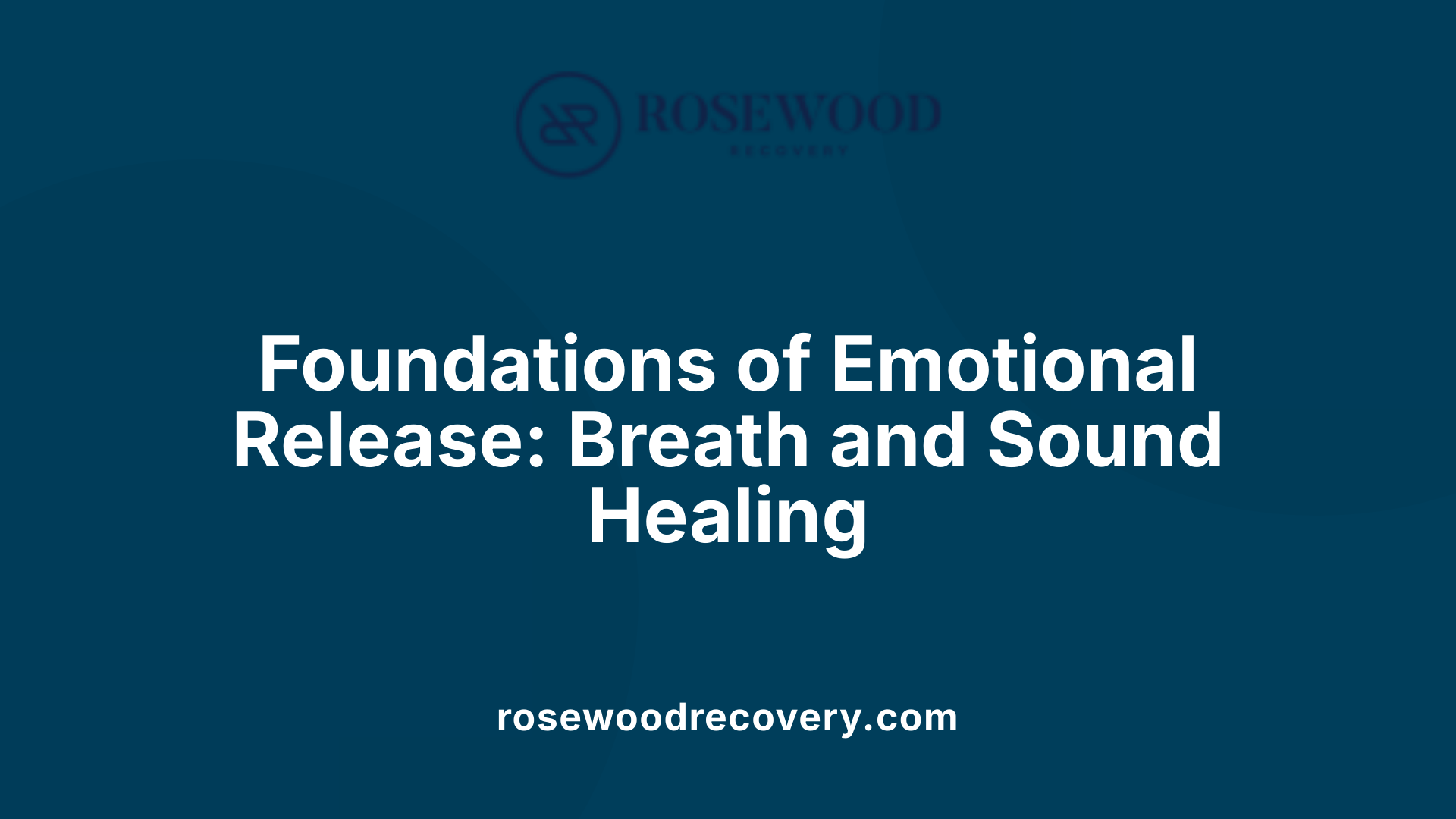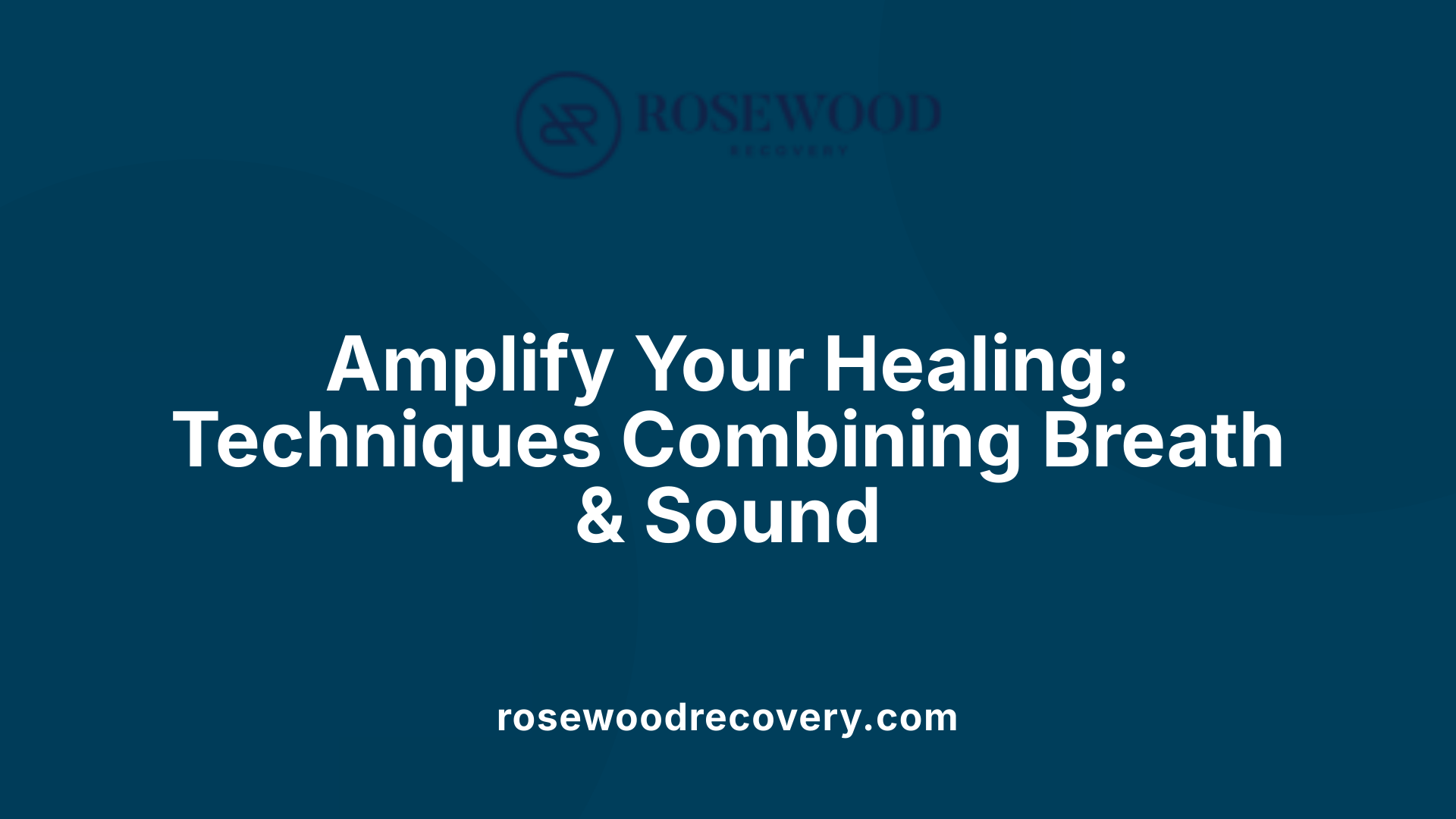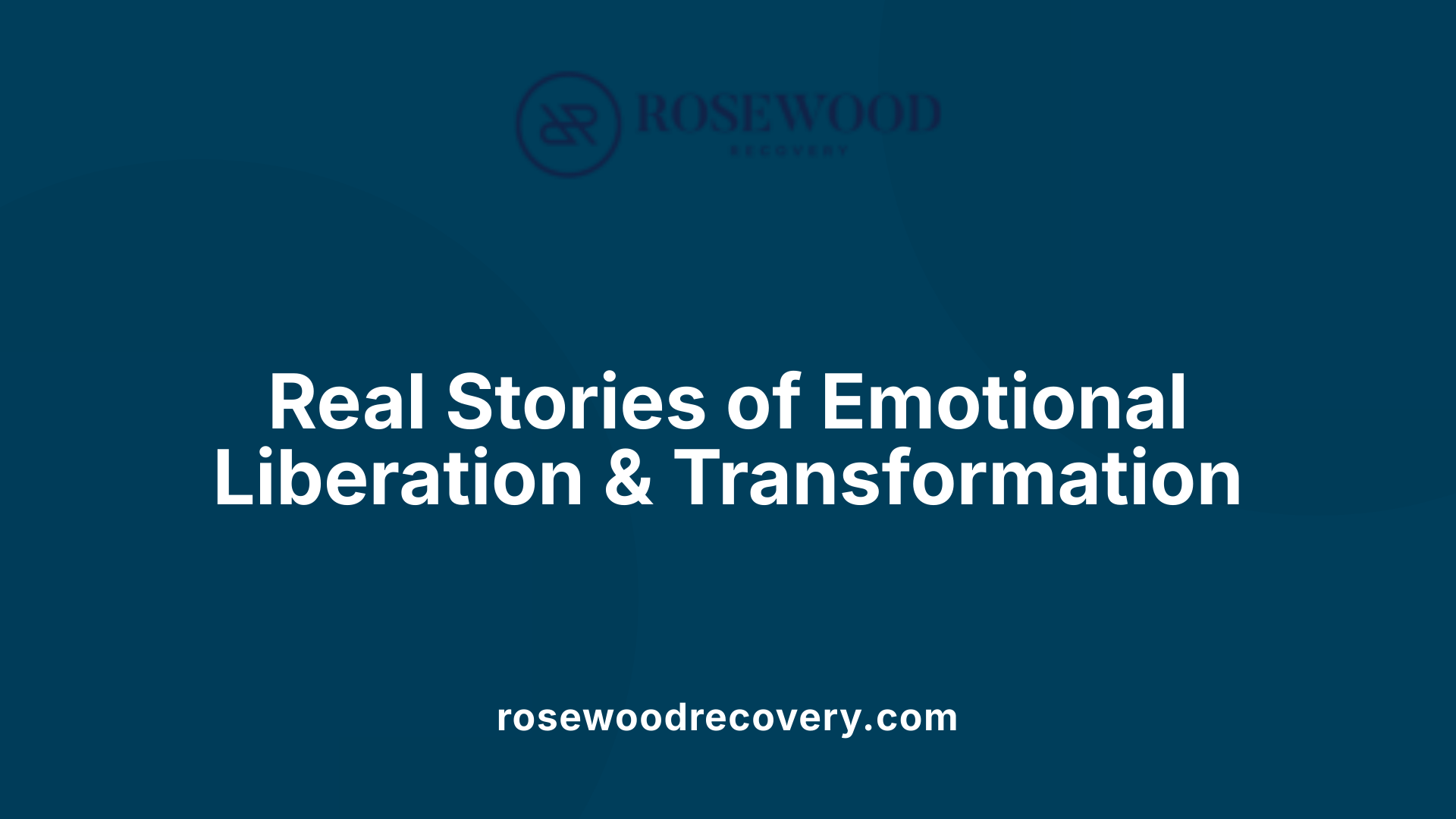Exploring the Synergy of Breath and Vibration in Emotional Healing
In recent years, the integration of breathwork and sound healing has gained recognition as a powerful modality for emotional release and personal transformation. This article delves into how conscious breathing techniques complement vibrational sound therapies to facilitate trauma processing, emotional regulation, and holistic well-being. By examining scientifically-backed insights and experiential accounts, we reveal the profound ways these practices work together to unlock inner peace and resilience.
Understanding Breathwork and Sound Healing: Foundations for Emotional Release

What is breathwork and sound healing, and how do they work together?
Breathwork involves conscious and intentional breathing exercises designed to enhance physical, emotional, and mental well-being. Techniques like diaphragmatic breathing, Holotropic Breathwork, or the Wim Hof method aim to activate the parasympathetic nervous system, reduce stress, and facilitate emotional release. Sound healing, on the other hand, uses vibrational energies from instruments such as gongs, singing bowls, tuning forks, and chimes to promote relaxation, balance, and energetic harmony within the body.
When combined, these practices form a complementary approach to trauma and emotional healing. The vibrations from sound therapy help dislodge energetic blocks and induce altered states of consciousness, while breathwork deepens these states by steadying the nervous system and fostering mindfulness. Together, they create a powerful environment conducive to emotional catharsis, insight, and self-healing.
What role does breathwork play within sound healing and emotional release practices?
Breathwork is central to facilitating trauma release and emotional processing within sound healing sessions. By consciously controlling breathing patterns, individuals can activate the vagus nerve and shift into states of calmness and openness. This regulation allows suppressed emotions—such as grief, anger, or fear—to surface and be expressed safely.
Within sound healing, breath engages the autonomic nervous system and sets the stage for deeper resonance and emotional exploration. The sound vibrations, like those from gongs or singing bowls, enhance the effects of breathwork by physically moving through tissues and organs, helping to release tension and stagnant emotions. This synergy fosters profound emotional insights, promotes nervous system regulation, and supports holistic healing.
Connecting techniques for deeper healing
Practitioners often combine breathwork with sound therapy to amplify their healing benefits. For example, guided breathing exercises paired with sound baths can deepen relaxation, reduce mental clutter, and facilitate the release of stored trauma. This integrated approach is increasingly used in therapeutic settings, retreats, and workshops to assist individuals on their journey of emotional liberation and self-discovery.
Techniques and Methods: How Breathwork Amplifies Vibrational Therapy

What techniques and methods of breathwork are used in sound therapy?
In sound therapy, a variety of breathwork techniques are utilized to promote relaxation, facilitate emotional release, and enhance mental clarity. Commonly employed methods include diaphragmatic (belly) breathing, which engages the diaphragm to deepen breath and improve oxygen flow. Box breathing, also known as square breathing, involves inhaling, holding, exhaling, and holding again in equal counts, usually four seconds each, to ground the nervous system.
Alternate nostril breathing balances the hemispheres of the brain and calms the nervous system, making it a popular choice during sound baths or guided meditation.
Resonant breathing, which aims for around five breaths per minute, helps synchronize heart and brain activity, fostering a state of calm and focus.
For deeper emotional and consciousness exploration, advanced practices such as holotropic breathwork, developed by Stanislav Grof, involve rapid, intense breathing patterns that induce altered states of consciousness. The Wim Hof Method combines deep, oxygen-rich breaths with cold exposure to boost energy and resilience.
Pranayama techniques like 4-7-8 breathing (inhale for four seconds, hold for seven seconds, exhale for eight seconds) and Lion’s Breath, which involves vocalizing a roar while exhaling, are used to release tension and stimulate emotional processing.
By integrating these methods with vibrational sound therapy—through instruments like gongs, singing bowls, and tuning forks—practitioners can deepen relaxation, unlock suppressed emotions, and access higher states of awareness.
How does the integration of breath and sound deepen states of relaxation?
Combining conscious breathwork with vibrational sound creates a synergistic effect that significantly enhances relaxation. The rhythmic qualities of breath help regulate the autonomic nervous system, shifting the body from fight-or-flight into a state of rest and digest.
Simultaneously, sound vibrations—especially those at specific frequencies—entrain brainwaves into alpha, theta, or delta states, which are associated with deep relaxation, meditation, and subconscious processing.
This harmonious interaction between breath and sound helps dislodge energetic blockages, calm the vagus nerve, and lower cortisol levels. As a result, individuals often experience profound emotional releases, mental clarity, and physical sensations of peace.
Practitioners frequently use guided sessions that incorporate both slow, controlled breathing and immersive soundscapes, facilitating a deeply relaxed state where emotional and psychological healing can naturally unfold.
By aligning breath with vibrational frequencies that resonate with specific chakras or emotional themes, this combined approach supports balanced energy flow, emotional integration, and holistic well-being.
The Scientific and Therapeutic Impact of Breath and Sound on Emotions

How does breathwork affect emotional healing from a scientific perspective?
Breathwork significantly influences emotional health by acting directly on the autonomic nervous system, particularly by boosting the parasympathetic branch responsible for relaxation and recovery. Scientific studies have shown that intentional breathing exercises, such as slow diaphragmatic breathing, increase heart rate variability (HRV), which correlates with better emotional regulation and resilience.
Research indicates that consistent breathwork can lower stress hormones like cortisol and reduce symptoms of anxiety and depression. Neurophysiologically, breathwork modulates activity within brain regions that process emotions—these include the limbic system, which governs affective responses, and the insula, involved in interoception or the perception of internal body states. The practice helps synchronize neural circuits, improving coherence across the brain’s emotional centers, and supports neuroplasticity, allowing better management of stored traumatic memories.
How do sound frequencies influence brainwaves and emotional states?
Sound healing employs vibrational frequencies from instruments like singing bowls, gongs, and tuning forks to entrain brainwaves, shifting consciousness into states associated with relaxation and emotional processing. For example, specific sound frequencies, such as alpha, theta, and delta waves, are linked with calm, meditative, and deep sleep states, respectively.
When sound waves interact with the body, they stimulate the vagus nerve and other autonomic pathways, helping to regulate heart rate, breathing, and mood. Binaural beats in the theta range, for instance, are known to facilitate access to subconscious memories and emotional patterns, enabling deeper emotional work. Furthermore, the physical vibrations from sound instruments can dislodge energetic blockages associated with powerful emotions like grief, anger, or fear, allowing emotional release and healing.
What evidence supports trauma release and emotional regulation through breath and sound practices?
Multiple studies demonstrate that both breathwork and sound therapy can reduce cortisol levels, lower stress, and promote relaxation. Therapeutic sessions involving sound baths and guided breathwork have been reported to decrease symptoms of PTSD and other trauma-related conditions.
Participants often experience emotional catharsis, feeling a release of pent-up emotions like sadness or anger, while also achieving a sense of calm and clarity. Clinical trials suggest that these practices support the rebalancing of nervous system functions, improve heart rate variability, and enhance emotional resilience. Combined, breath and sound therapies provide a body-based, non-verbal avenue for trauma integration, bypassing overactive analytical processes and facilitating subconscious emotional processing.
| Technique | Effect | Nervous System Impact | Typical Use Cases | |---------------------------|------------------------------|--------------------------------------------|---------------------------------------------------| | Deep diaphragmatic breath | Calm, reduction of anxiety | Activates parasympathetic nervous system | Stress relief, trauma release, emotion regulation | | Binaural beats | Altered consciousness | Influences brainwave entrainment | Deep relaxation, subconscious access | | Sound baths | Deep relaxation, emotional catharsis | Stimulates vagus nerve, resets vibrational balance | Stress reduction, emotional processing | | Holotropic breathing | Non-ordinary states| of consciousness | Enhances self-awareness and emotional release | PTSD, personal growth |
Engaging regularly in these practices can profoundly influence emotional states, promote trauma healing, and foster a sense of inner harmony. Their effectiveness is supported by neurophysiological insights and growing empirical evidence, confirming their position as valuable tools in psychological and physical healing.
Stories of Transformation and Personal Accounts

Are there success stories or personal accounts of emotional healing through breathwork?
Yes, many individuals have shared inspiring stories of how breathwork has facilitated emotional breakthroughs. People like Nadezda, Marger, and Conni describe profound moments where they released deep-seated grief, healed from trauma, and experienced significant emotional clarity.
Practitioners and participants at clinics such as Good Vibes Yoga often recount how guided breathwork sessions fostered feelings of peace, joy, and emotional resilience. These experiences help many reconnect with suppressed feelings and gain important insights into their inner worlds.
Personal accounts frequently mention the development of self-acceptance and empowerment after practice. Many report that regular breathwork has helped them manage anxiety, dissolve fears, and build inner strength. For example, some describe how intense emotional releases during sessions led to long-lasting feelings of relief and liberation.
Overall, these stories highlight technology's powerful capacity to support emotional healing, illustrating that guided breathwork can unlock transformation and foster greater well-being.
Holistic and Integrative Approaches: Retreats, Workshops, and Practitioners
 Educational programs that combine breathwork and sound healing are increasingly popular for fostering deep healing and personal growth. These retreats and workshops offer participants a comprehensive experience that taps into the body's energetic and emotional systems. They often feature guided sessions led by experienced practitioners, integrating various techniques such as biodynamic or holotropic breathwork with sound baths using gongs, singing bowls, and tuning forks.
Educational programs that combine breathwork and sound healing are increasingly popular for fostering deep healing and personal growth. These retreats and workshops offer participants a comprehensive experience that taps into the body's energetic and emotional systems. They often feature guided sessions led by experienced practitioners, integrating various techniques such as biodynamic or holotropic breathwork with sound baths using gongs, singing bowls, and tuning forks.
Effectiveness of trauma-informed practices is well-supported by evidence showing that these approaches can significantly reduce symptoms of PTSD, anxiety, and emotional distress. By creating safe spaces guided by trauma-sensitive methodologies, practitioners ensure participants experience emotional release, healing, and integration at a comfortable pace.
The combination of sound, breath, and emotional therapy within retreat settings promotes profound transformation. Sound vibrations help dislodge energetic blocks and induce deep relaxation, while conscious breathing techniques activate the parasympathetic nervous system and influence the vagus nerve. Together, they facilitate accessing subconscious memories, releasing suppressed emotions, and fostering inner peace.
How are breathwork and sound healing interrelated for healing and personal transformation?
Breathwork and sound healing are deeply interconnected practices that work synergistically to promote healing and personal transformation. Both utilize vibrational and respiratory techniques—breathwork through conscious control of breath to activate the parasympathetic nervous system and influence the vagus nerve, and sound healing through the use of specific sound frequencies and vibrations that entrain brainwaves into relaxed and expanded states. When combined, these practices enhance each other's effects: sound vibrations facilitate deeper states of consciousness and emotional release, while breathwork calms the mind and anchors awareness, enabling more profound insights. Vibrations from sound instruments physically move through tissues and energy centers, supporting cellular healing and tension release, while synchronized breathing patterns deepen relaxation and integration.
Exploring integrative retreats and workshops on breathwork and sound healing provides a nurturing environment for emotional liberation, trauma processing, and spiritual awakening. These programs are designed to educate, empower, and support individuals in their journey toward holistic wellness and self-awareness.
Embracing Conscious Breath and Vibrations for Lasting Healing
The integration of breathwork and sound healing represents a transformative approach to emotional well-being. Scientific insights, personal testimonials, and practical methods confirm their efficacy in releasing trauma, reducing stress, and fostering resilience. As awareness grows around these holistic modalities, more individuals are discovering their potential to access deep states of peace, clarity, and inner harmony. Embracing conscious breath and vibrational sound not only promotes healing but also empowers personal growth and spiritual connection. Practitioners and newcomers alike can explore these practices under guided settings, opening pathways to lasting emotional liberation and self-discovery.
References
- Breathwork for Healing Trauma: 3 Popular Techniques ...
- The Role of Sound Healing in Emotional Release Therapy
- Breathing & Sound Therapy
- The Power of Sound Bath and Breath Work - Good Vibes Yoga
- Benefits of Breathwork
- Breathwork and Sound Healing: The Complete Synergy ...
- Breathwork: What it Is & How it Works
- Can Breathwork Release Trauma?
- The Science of Breathwork: Unlocking the Power Within
- The Benefits of Sound Bath Healing and Breathwork

.jpeg)


